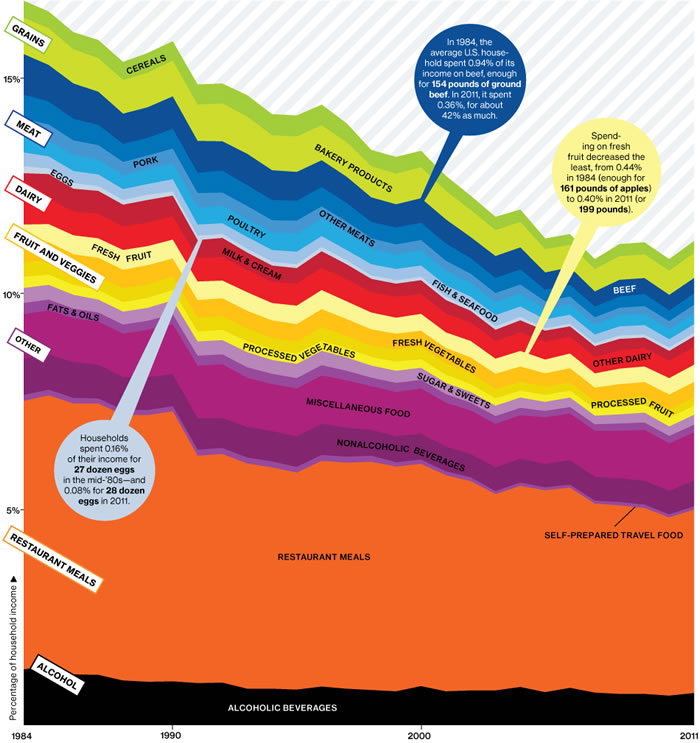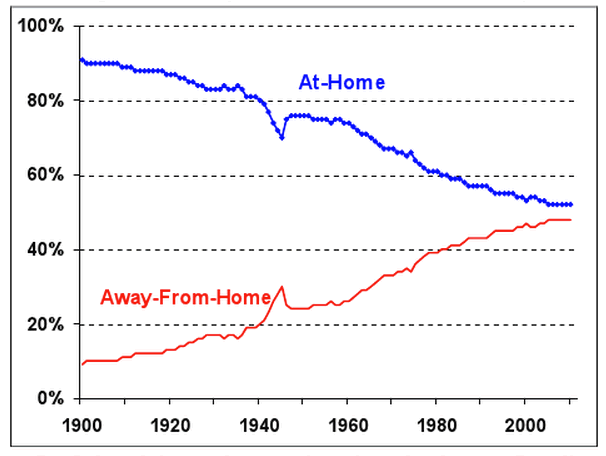Here are some charts illustrating a couple of interesting food trends in the US.
Americans are spending a smaller percentage of their income on food than ever. From America’s Shrinking Grocery Bill:
In 1984, the average U.S. household spent 16.8 percent of its annual post-tax income on food. By 2011, Americans spent only 11.2 percent. The U.S. devotes less of its income to food than any other country—half as much as households in France and one-fourth of those in India.

But you see that big orange slice of the chart?
We are also spending a larger percentage of our food budget on food prepared away from home than ever. From Cheap Eats: How America Spends Money on Food:

Looking at the chart, it seems like only a matter of time before we eat out more often than we eat in.
Our peak period of eating out was after the birth of our first child. It felt like we were whipping out the binder of take-out menus nearly every day. More recently, we completed the Dinner Boot Camp which contained a week-long plan for easy home dinners, and since then we’re on our 4th consecutive week of cooking dinner (and the following day’s lunch) at home at least 5 times a week. It’ll be hard to keep up, but doing a bit of planning before every week really does go a long way.
 The Best Credit Card Bonus Offers – 2025
The Best Credit Card Bonus Offers – 2025 Big List of Free Stocks from Brokerage Apps
Big List of Free Stocks from Brokerage Apps Best Interest Rates on Cash - 2025
Best Interest Rates on Cash - 2025 Free Credit Scores x 3 + Free Credit Monitoring
Free Credit Scores x 3 + Free Credit Monitoring Best No Fee 0% APR Balance Transfer Offers
Best No Fee 0% APR Balance Transfer Offers Little-Known Cellular Data Plans That Can Save Big Money
Little-Known Cellular Data Plans That Can Save Big Money How To Haggle Your Cable or Direct TV Bill
How To Haggle Your Cable or Direct TV Bill Big List of Free Consumer Data Reports (Credit, Rent, Work)
Big List of Free Consumer Data Reports (Credit, Rent, Work)
The implication, corroborated by the second chart, is that more money is being spent to eat out. In the first chart, it does look as if the % of income on restaurant food has decreased from about 8% to about 6% from 1984 to 2011 also. Is income increasing relative to the cost of food? Doubtful. What explains the overall lower % spent on ALL food, home and out?
This is odd indeed. Are we in a period where food prices are skyrocketing? Oh wait, 2011 is the last date on this chart and there is an uptick…
The linked “Cheap Eats” article says that income IS increasing relative to the cost of food, worldwide, which explains the lower % spent on all food.
This feels like good news but necessarily isn’t.
The cost of other things – healthcare, rent/mortgage, daycare etc has gone up so much that americans spend less on other things including food
or the other explanation is maybe food including fast-food became cheaper relative to rising income ?
Most of the time we forget that calories in the first world are super cheap. Fast food is especially cheap for the amount of calories it contains. America may have a lot of economic issues, but lack of access to raw calories (even for those in poverty) is not one of them. Restaurant food tends to be more calorie-dense than food cooked at home, as is unhealthy food in general.
This chart aligns well with the fact that we have an overly obese population that eats a lot of unhealthy food. What people struggle with is paying for the fresh/healthy stuff and having enough time to prepare it.
What i have noticed in my own life and others that I have asked about their eating habits is, that it is just so easy to eat out. It is faster than preparing something at home and because we are moving away from the agricultural life style more and more, even our eating habits are changing over time. Preparing a meal is time consuming and if we are not already good at cooking, it can be a learning curve. Fast food is convenient and dinner at a restaurant can be more social and fun. However there are consequences to moving away from preparing our own food right at home, both health wise and financially.